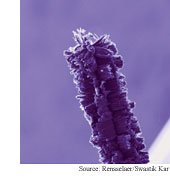|
NEWS
|
Greener hydrogen
Spraying fine droplets of vegetable oils or biofuels
onto a very hot catalyst in the presence of oxygen produces
hydrogen without forming the layers of carbon that deactivate
catalysts. The technique could be used to produce hydrogen
from renewable resources for fuel cells or hydrogen combustion
engines. (Renewable
Hydrogen from Nonvolatile Fuels by Reactive Flash Volatilization,
Science, November 3, 2006)
Hyper breathalyzer
A breath analyzer that doesn't require sample
preparation rapidly produces a molecular fingerprint of
a breath sample. The device could be used to diagnose
diseases and for medical research. (Rapid
In Vivo Fingerprinting of Nonvolatile Compounds in Breath
by Extractive Electrospray Ionization Quadrupole Time-of-Flight
Mass Spectrometry, Angewandte Chemie International
Edition, published online November 2, 2006)
Nanotubes on metal
 A pair of techniques put arrays of carbon nanotubes
on metal surfaces, which provides strong electrical contacts
for the nanotubes. Metal-mounted nanotubes promise high-performance
capacitors, like those used in electric and hybrid cars,
and field emitters, which could be used in high-resolution
displays and scientific instruments. One technique uses
a high-temperature nickel alloy that can withstand the
heat of the nanotube growth process, and the other transfers
arrays of nanotubes grown on silicon to low-temperature
solders on metal surfaces. (Direct
Growth of Aligned Carbon Nanotubes on Bulk Metals,
Nature Nanotechnology, November 2006; Contact
Transfer of Aligned Carbon Nanotube Arrays onto Conducting
Substrates, Applied Physics Letters, October
16, 2006)
A pair of techniques put arrays of carbon nanotubes
on metal surfaces, which provides strong electrical contacts
for the nanotubes. Metal-mounted nanotubes promise high-performance
capacitors, like those used in electric and hybrid cars,
and field emitters, which could be used in high-resolution
displays and scientific instruments. One technique uses
a high-temperature nickel alloy that can withstand the
heat of the nanotube growth process, and the other transfers
arrays of nanotubes grown on silicon to low-temperature
solders on metal surfaces. (Direct
Growth of Aligned Carbon Nanotubes on Bulk Metals,
Nature Nanotechnology, November 2006; Contact
Transfer of Aligned Carbon Nanotube Arrays onto Conducting
Substrates, Applied Physics Letters, October
16, 2006)
Nerve-nanotube circuit
Nerve cells grown on films of electrically-conducting
single-walled carbon nanotubes make it possible to electrically
stimulate the nerve cells without damaging them. The technique
could be used to make medical implants that control pain
or stimulate motor neurons. (Stimulation of Neural Cells
by Lateral Currents in Conductive Layer-by-Layer Films
of Single-Walled Carbon Nanotubes, Advanced Materials,
November 15, 2006)
Spying on an electron
Shining a weak laser beam on a single electron
trapped in a tiny speck of semiconductor material and
measuring how the light changes reveals the state of the
electron while only minimally disturbing it. The method
could lead to ways of reading out data in quantum computers
and quantum communications systems without erasing it.
(Nondestructive
Optical Measurements of a Single Electron Spin in a Quantum
Dot, Science Express, November 9, 2006)
Light logic
A system of calculating the ones and zeros of
digital information using the polarization of light opens
a new route to making all-optical computer processors.
All-optical processors promise to speed communications
equipment that ordinarily requires light signals to be
converted to electrical signals and back. (Complete
All-Optical Processing Polarization-based Binary Logic
Gates and Optical Processors, Optics Express,
October 16, 2006) |
FEATURES
|
View
from the High Ground: ICL's John Pendry
Physics as machine tool, negative refractive
index, metamaterials, shattered wine glasses, higher capacity
DVDs, scientific backwaters, risk perception and practice,
practice, practice.
|
How
It Works: Quantum computing: qubits
Photons, electrons and atoms, oh my! These particles are
the raw materials for qubits, the basic building blocks
of quantum computers. |
|
 |
News RSS feed 
Blog RSS feed 
Bookshelf RSS feed

New: TRN's
Internet Services
TRN's Jobs Center
|
| |
|
| |
|
| |
"Physics
is to the rest of science what machine tools are
to engineering. A corollary is that science places
power in our hands which can be used for good or
ill. Technology has been abused in this way throughout
the ages from gunpowder to atomic bombs."
- John Pendry, Imperial College London |
|
| |
|
| |
Thanks
to Kevin from
GoldBamboo.com
for technical support |
|

